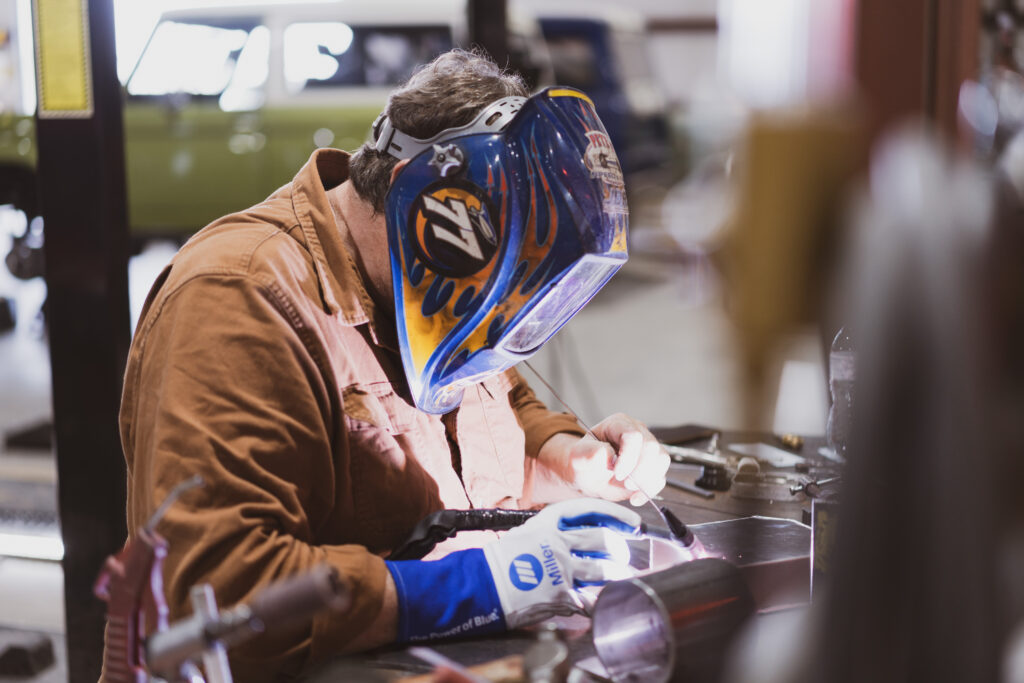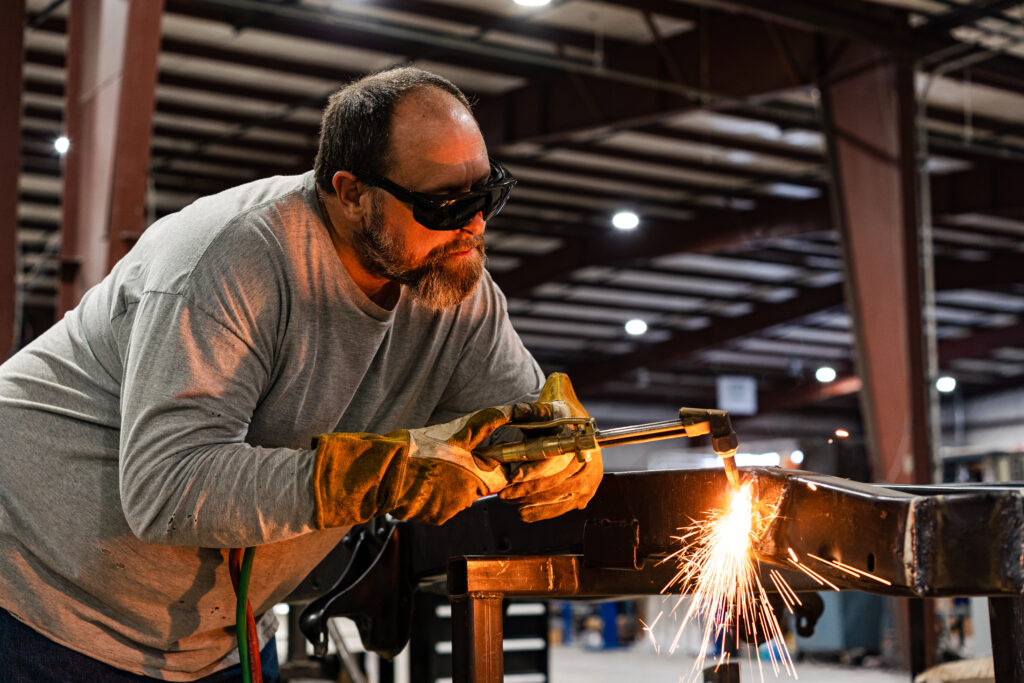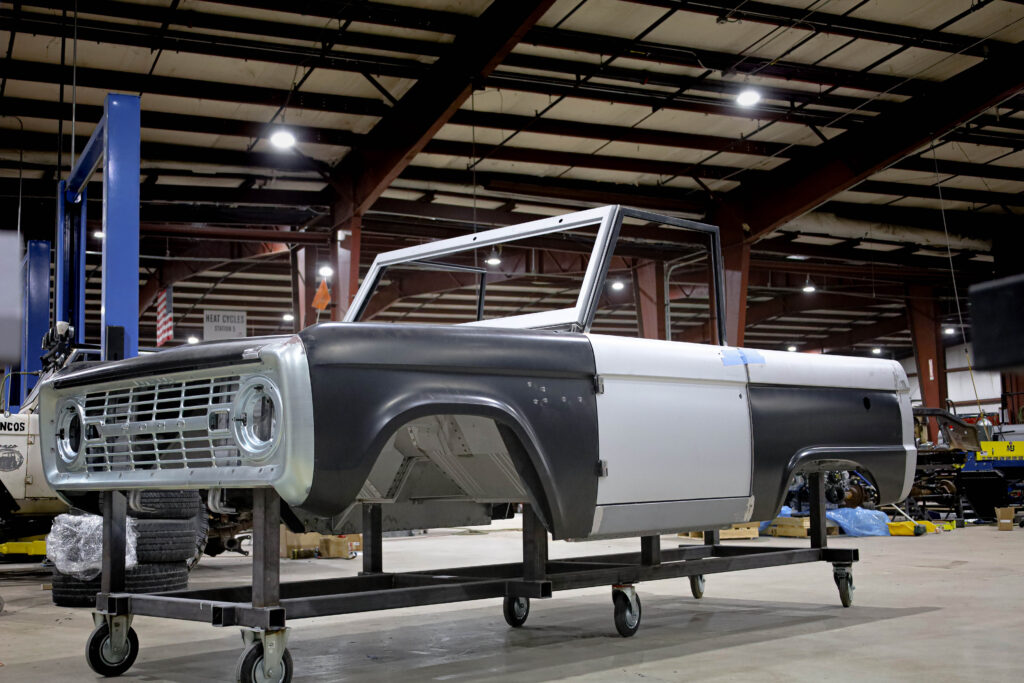by Lauren Duensing, FF Journal
At Gateway Bronco, Hamel, Illinois, Seth Burgett and his team of skilled workers design and restore Broncos the Henry Ford way—on an assembly line. Gateway’s 60,000-sq.-ft. shop is vertically integrated from metal fabrication to powder coating, paint and final assembly.
“We’re taking a primitive Ford utility vehicle and turning it into a modern sport SUV,” Burgett says. He made the decision to
get into the Bronco business after taking a cross-country trip from Walden Pond to California with his then-seventeen-year-old daughter. “I picked her up at LaGuardia Airport in an old, original-paint Bronco and drove to Walden Pond. From there,
we went to Niagara, Glacier, Seattle, down to Big Sur—five weeks, 5,000 miles and an original Bronco. We learned it inside
and out.

“Before I became a professional, I did restorations out of necessity,” continues Burgett. “If I wanted a decent car, I had to take an old, rusty car and do the work myself. I did sheet metal and panel replacement, then auto body work. I painted my first car at 14.” After college, which he paid for by painting cars, he built a career in engineering and leadership, so, for him, Gateway Bronco is “coming back to those roots. It brings me so much fun and enjoyment.” He says a big differentiator for Gateway was becoming licensed by Ford to build Broncos.
Attention to detail
Restoring Broncos has a set of unique challenges since they’re four-wheel drive vehicles that have been used for farm work
and adventuring since they rolled off the line in the 1970s. “We have to fix all those panels,” says Burgett, “and that’s not an easy task.”

During final assembly, all vehicle manufacturers check to ensure that a car’s panels are joined correctly and adhere to tight tolerances, which requires accurate gauging of gaps and clearances. Gateway uses laser alignment, fixturing and repeatability until “we get a really refined flush gap that meets our standards. If it doesn’t, it doesn’t move forward. Quality control is dominant in our success.” Each build undergoes at least 18 proprietary structural reinforcements, as well.
Burgett says he tends to partner with companies for tools and equipment that are going to provide the highest quality. “TIG welding and spot welding are a big component of what we do, and we have the whole Miller line. Mittler Bros. is who we use for all our metal forming and sheet metal brakes.”
Gateway’s builds include an EV Bronco, and customer requests have ranged from traditional to unusual, including a Bronco with infrared lights “so you could drive “down the interstate, without your headlights on, wearing night vision goggles,” a push-button rear window that “goes down vertically like an old station wagon,” and a gun case hidden under the metal bed. “Press a button, and the entire bed comes up with the gun case underneath. It could hold 10,000 rounds of ammo.”

Past and future
“Taking something that looks so primitive, raw and abused —it’s like polishing an old piece of brass,” says Burgett. “It’s so satisfying to see a vehicle go from rough metal to bodywork. The finished paint work is probably my favorite part because I have an auto-body background, but my mechanical engineer side also enjoys improving the drivability of vehicles.”
Gateway generally hires about two fabricators every quarter as its business continues to grow—and it has no problems finding people who want the job, either training them internally or hiring from the outside. The company also offers an Innovators scholarship in partnership with the Carroll Shelby Foundation, McPherson College and the Carroll Shelby Automotive Program at Northeast Texas Community College. Scholarships worth $5,000 are given each spring so a student at each school can complete an eight-week summer internship at Gateway’s facility. “By working with top automotive tech programs, we hope to inspire and prepare the next generation of young people to push the envelope through meaningful careers in this exciting industry,” says Burgett.
“Our future is continued innovation,” he continues. “We have continued to push the envelope for these vehicles, refining the laser scanning of the sheet metal as well as moving more of the fabrication to the spot welding side. We’re now dipping in to the million-dollar-vehicle category, as well.”
Subscribe to our Newsletter!
Stay up to date with our latest builds, For Sale Inventory and more.
 Instagram
Instagram